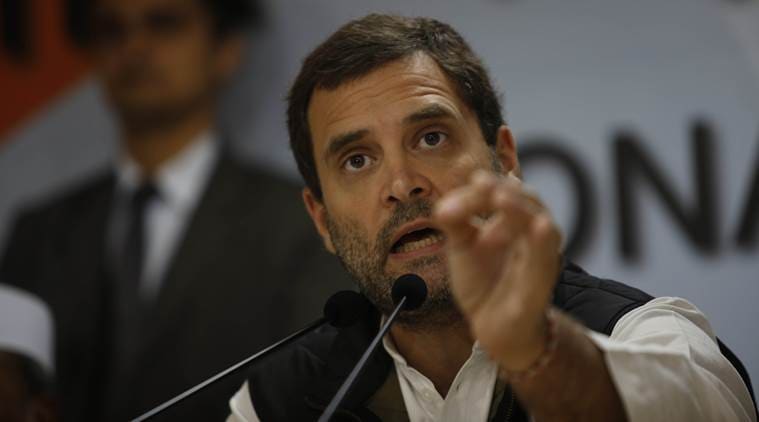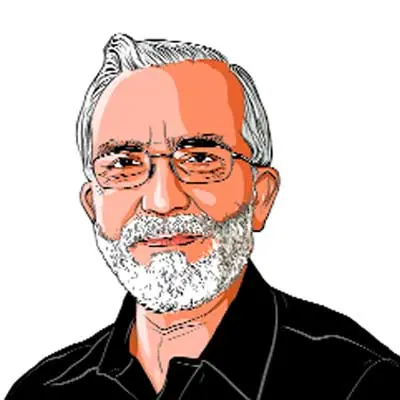Opinion Signifying nothing
Rahul Gandhi’s hyperactivity only conceals the larger malady: His party still lacks a plan.
 Congress Vice President Rahul Gandhi at the 132nd foundation day of the INC in the party HQ in New Delhi on wednesday. Express Photograph by Neeraj Priyadarshi New Delhi 281216
Congress Vice President Rahul Gandhi at the 132nd foundation day of the INC in the party HQ in New Delhi on wednesday. Express Photograph by Neeraj Priyadarshi New Delhi 281216  Congress Vice President Rahul Gandhi. (Express Photo by Neeraj Priyadarshi)
Congress Vice President Rahul Gandhi. (Express Photo by Neeraj Priyadarshi)
As another year in wilderness ends for the Congress, it might derive some satisfaction from the show of energy by its leader-in-waiting. It has been a busy year for Rahul Gandhi in terms of leading his party’s attack on the prime minister. Besides his desperate attempts to capture the political theatre of the national capital, Rahul spent a lot of time in Uttar Pradesh during this year. He continued to hog the headlines, particularly towards the end of the year.
Throughout the demonetisation episode, he was vocal, active and visible. In fact, he gave tough competition to both Mamata Banerjee and Arvind Kejriwal as the prime target of trolling by Modi-devotees on social media, and criticism by suave Modi-supporters in the press and electronic media. The Congress would surely be hoping that the near paranoid attacks on Rahul would one day help him emerge as the main contender to Modi.
WATCH VIDEO | Demonetisation Deadline: Congress Attacks PM Modi: Find Out More
But then, presence in the headlines is not enough to turn the political tide. Throughout the year, Rahul’s tentativeness on the leadership question and the recurrent media gossip about the ascension of Priyanka have been counterproductive themes for the Congress. Nor have Rahul or his party been able to respond to charges of dynastic control of the party. So, Rahul continues to be the hesitant heir, pushed both by obsessive opponents and self-serving sycophants.
His hesitancy is obvious from the absence of a game-plan. Strident criticism of Modi would get headlines but what the Congress needs right now is support among a cross-section of the voters or alternatively, cultivation of a sizable social bloc. While the Congress is unlikely to make much of a dent in UP, and in the (more than likely) event that it would lose both Manipur and Uttarakhand and fail to wrest Punjab, the mother of all tests would come towards the end of 2017 in Gujarat.
In this context, Rahul’s vigorous action remains inadequate because of three non-actions. One, he could have intervened in the debates on the issue of dynasty by clarifying either that he does not desire to take over the party reins or that he does not intend to lead a government, or both. Two, he could have distanced himself from the authoritarian legacy of the Emergency and found more imaginative ways of celebrating Indira Gandhi’s centenary. Three, and most importantly, leaving daily criticism of the government to his colleagues, he could have concentrated on core issues of difference between Congress and the ruling party.
But Rahul’s hyperactivity only conceals the larger malady: He is unable to chart the course for the party. Organisationally, this has not been possible because of internal unease about the direction to be taken. He has also not been able to sort out the much-rumoured tussle between those who want to construct a new Congress and those who want to live off the remnants of palatial patronage. This stalemate has stalled any rejuvenation of the party. But besides these structural limitations of the Congress party, Rahul as the leader suffers also from an ideological ambiguity and resultant absence of a consistent message. So, he operates without an organisational anchor or an ideological beacon. The anti-Modi symbol called Rahul, thus, remains enigmatically empty.
This situation is as much about his inadequacy as about the party’s inadequacy. A party, through its leadership, organisation, cadres and network of like-minded groups, can, and must, make its presence felt in six arenas. In the past two and a half years, however, the Congress has only further disappeared from these crucial arenas of competitive politics.
First, electorally, it has slipped further. In no single state election has the party shown any signs of revival nor retention of a core constituency. This is not unexpected in view of the historic defeat it faced in 2014. Confusing electoral strategies have only added to that slide — in West Bengal and Tamil Nadu, where the party could not have gained from alliances, it went ahead with an alliance and in Assam where an alliance might have helped, it went alone. Bihar, perhaps, was the only sober decision that the party took in the past two years. Congress’s UP and Punjab campaigns too, leave much to be desired in terms of strategy and outreach.
Two, the performance of the party where it is in power has been dismal if not disastrous. In state after state, the Congress has only proved further that it is no more a party of governance. This is true of states where it already lost in the last three years; it is equally true of states where it will face the electorate in the next couple of years — Uttarakhand, Manipur, Himachal and Karnataka.
Also read | PM Modi sacrificed common man in ‘yagna’ against black money, says Rahul Gandhi
Three, its performance in parliament has not earned it either positive media publicity or the confidence that it has substantial policy interventions to make. These two and half years have been riddled with critical issues — the agrarian crisis, economic slowdown, Indo-Pakistan relations, deterioration in J&K, demonetisation, face-off with the judiciary and so on. But barring the tit-for-tat stalling of parliament, the party never came off as an effective parliamentary opposition. It is difficult to remember any substantial intervention by Congress MPs (barring Manmohan Singh’s, recently) in parliamentary debates. Four, given its dilapidated organisation, the party has not been able to come out on the streets to lead, mobilise and galvanise the public on national or local issues. The Congress cannot be credited with raising and consistently pushing any issue in a state where it is not in power.
Five, the party lacks an organisational network that would work among the masses, engage in constructive work, build public service networks and earn the people’s goodwill. The yawning gap between the party the ordinary public becomes even more visible when we look for the second level, seemingly non-political, networks that the Congress can draw upon. The drug menace in Punjab, for instance, could have been handled through a sustained extra-party platform rather than merely accusing the government.
In the last instance, the party has not positioned itself clearly and resolutely on core ideological issues. The over-enthusiastic elements from the BJP have given enough space for such positioning both on issues of cultural values and welfare and development. But the Congress only appears more and more confused when confronted with the challenge of ideological positioning. It is one thing to be centrist and another to run away from taking a stand.
So, an improvement in the leader’s report card cannot bring solace if the party’s report card draws a blank. Yet another year has ended with a lot of noise and TV soundbites about Rahul, but without much indication that it would help the Congress. For yet another year, Rahul has been everywhere but the Congress is nowhere in sight.




